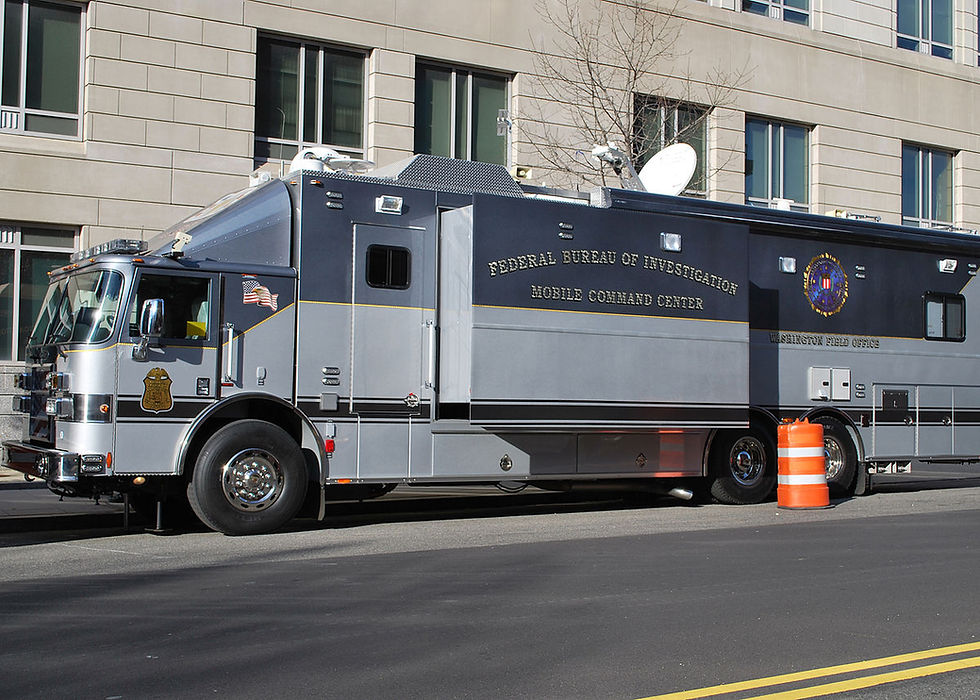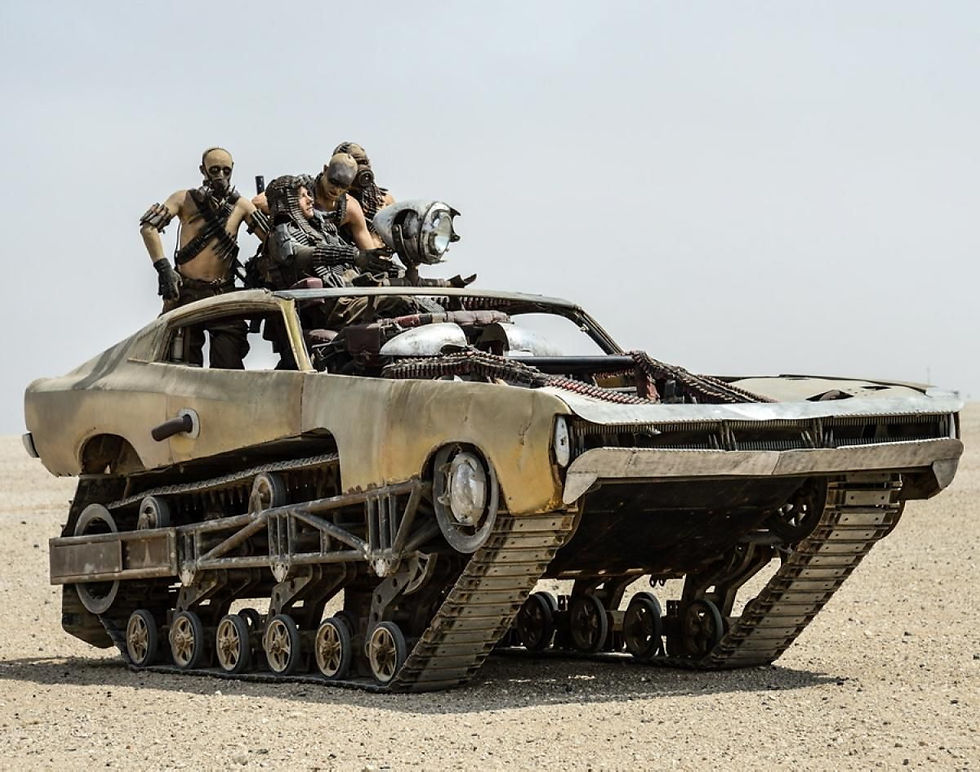- Jun 20, 2023
- 6 min read
If you have never seen one in real life, you could be considered fortunate but you have certainly seen one on television. Mobile Command Vehicles (MCV) or trailers are perhaps the coolest looking equipment in the world of emergency management.

As the world is falling apart and people are scattered throughout the streets screaming and searching for loved ones, you can see smoke rising on the horizon and the sound of helicopters almost blocks out the sound of our hero and star of our film arriving in a futuristic looking mammoth vehicle crowned with an array of antennas and satellite dishes. Emblazoned across the side of the vehicle are the words: MOBILE COMMAND.
Somehow, you know everything is going to be okay.
Yep. That’s the “glory story” and you see it all the time in movies. What you don’t see is the blood, sweat and tears that go into designing and planning to make that motorized beast what it is. What you can’t comprehend is the hundreds if not thousands of hours that went into creating a vehicle that would really work when the world was falling apart.
Mobile command vehicles are deployed in real life to improve or reestablish communication and coordination during emergency incidents and special security events nationwide. The mobile command vehicles leverage satellite and internet access, as well as interoperable radios and video capabilities to improve communication between government assets and other federal and local response and support assets.

When it comes to the Feds, the U.S. Department of Homeland Security (DHS), National Protection and Programs Directorate (NPPD), Federal Protective Service (FPS) is responsible for protecting property owned, occupied and secured by the U.S. Government as well as the people on that property. The Mobile Command Vehicle (MCV) program supports the Federal mission through the provision of mobile, on-site platforms for command, control and communications during terrorist attacks, natural disasters, National Special Security Events and other similar occurrences. The MCVs can rapidly deploy to any location in the continental United States where the communications infrastructure is inadequate or has been disrupted, or where enhanced interoperability among law enforcement agencies is needed.
Incident management in the nation’s current threat environment requires mobility, interoperability among public safety agencies, reliability and cost effectiveness. Mobile Command Vehicles meet this need. MCVs can support daily operations as well as special deployments of the FPS Crisis Response Teams and other organizational elements. These highly specialized vehicles augment the capabilities of the Fed’s dispatch and call centers, known as MegaCenters, by allowing them to remotely dispatch units and link different radio systems together without the need to actually send personnel to the scene. Each MCV also provides an environmentally controlled platform for on-scene command and control functions, with small conferencing areas, video-teleconferencing, data analysis and processing, and information acquisition and management for situational awareness and common operating picture development.

Now, when the situation is more localized such as a major tornado in a city or a massive flood or hurricane, the MCV can be seen operated by agencies such as a Sheriff’s office, police department, fire department, county government, State police and others. Each of these MCV’s is different, supporting a different role in response. Each vehicle or trailer has to be designed by the people that will use the vehicle and by specialists with years of experience in response so that no detail is overlooked.
One cannot simply go to an RV dealer and order a command vehicle. Each vehicle must be as “smart” as possible and designed with it’s future environment in mind which takes the heart and mind and soul of true emergency managers.

Do we want to sleep in it? Do we want desks? Can we design a desk that becomes a bed? We need monitors but can they be stowed away? How do monitor the outside from the inside? Will we need to prepare food in our vehicle? What is the worst environment this vehicle could encounter and how do we design the vehicle for that?
At X-Bomb we have that heart, mind and soul. Aside from just being designers, X-Bomb creates a collaborate team for each build that includes specialists in different fields of response as well as emergency management personnel that can lend insight into the design and execution of the building plans. We strive to partner with vendors that don’t just specialize in the “cool stuff” like emergency lighting but in the realms of communications, software, electronics, security, finishes, shelters, tools, portable response kits and much more.
It all sounds like a lot of work because it is, but we guarantee that a well-thought-out design that has been created with budget, efficiency, effectiveness and quality in mind can change the way you play the game.
Since I have spent so much time on the vision, design and building of a command unit, I want to talk about something that I have seen kill many projects for years. Over-engineering.
While we want to make sure that you have everything you need when you need in your trailer, the worst thing you can do is over-engineer. Today’s trend is to have the very best of everything even when you really don’t need EVERYTHING. Folks, it is still a trailer.
Before getting into detail, let me talk to you a bit about my background.
I have spent over 3 decades in emergency response and disaster response. I have spent the last 15 years in research and development of responder products and solutions. I have made every mistake there is to make, sometimes at the altar of marketing. Make it big so you look big, right?
My original background was in architecture and mechanical drafting with a short stint being spent with GM. I have been a part of developing over 40 products that are still presently on the market and have been part of design teams working on mobile command units and response trailers for over 15 years.
Everything I am sharing is not my opinion; it is my experience.
So what is over-engineering?

If we go to the strict definition, over-engineering refers to the fact of designing a product in a more complex way than necessary:
Over-engineering (or over-engineering, or over-kill) is the act of designing a product or providing a solution to a problem in an overly complicated manner, where a simpler solution can be demonstrated to exist with the same efficiency and effectiveness as that of the original design.
Nobody over-engineers with bad intentions. On many occasions, over-engineering happens because we try to anticipate the future and be ready for the unknown. That is actually our job in emergency response, right?
The reality is that nine times out of ten, that “just in case” never comes. But along the way, we have lost valuable time and increased the complexity of the project, something that we will carry throughout its whole life.
Another cause of over-engineering is often a lack of experience in the actual field. I have been under-impressed by many of the engineers and creators of today’s “fancy” command units as I find out they have TONS of experience in manufacturing or in mechanics or communications but have NEVER responded to a disaster so they have no idea what their creation will experience!
In general, the more senior you are, the less prone you are to over-engineer because you’ve already lived through quite a few situations where artificial complexity has exploded in your face. At X-Bomb, we don’t always have the answers or the experience so a large part of your custom-designed trailer or vehicle will be the investment of the folks we bring in that have the expertise your unit will need.
Here are some things I have seen cause over-engineering:
Loosely defined requirements. If an engineer does not have a well-defined problem, he will tend to overengineer to protect himself from uncertainty.
Boredom can also lead to over-engineering. Youth may also be a factor. If an engineer does not have exciting challenges to face, he may end up complicating any problem simply by trying something new. The younger the engineer or designer, the more “extras” get added simply because they are “new” and exciting but necessarily tested or proven in the field.
When I said at the beginning of the article that overengineering kills projects, I was not kidding. It has two particularly perverse effects on any system.
On the one hand, it increases development costs. If our engineers do not choose the simplest solution to address a problem, our costs in time and money increase, preventing us from completing the project.
On the other hand, it also increases your maintenance costs. Simple is just that…simple. When we complicate it, the complexity can grow exponentially, impacting our iteration speed.
If you are wanting a desk in your trailer that also becomes a bed that also becomes a fully stocked bar but can also be used as an awning on the outside of the trailer you are looking at the wrong company. We won’t do it because you shouldn’t want it.
Over-engineering kills products and projects. Much more than the absence of good engineering practices.
I love listening as much as I love talking. Listening is one of the things that brings me joy and laughter. One statement I love to hear is “I want all the bells and whistles”. When I hear this I usually will laugh out loud at the very thought. At almost 60 years of age, I cannot think of two times I have used a bell and only a few more times when I used a whistle. What on earth would I do with them all?




